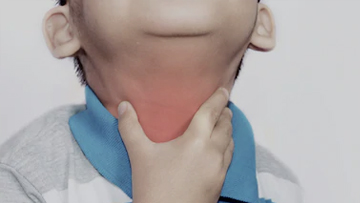Diphtheria is an infectious disease caused by the bacterium Corynebacterium diphtheria, which primarily infects the throat and upper airways, and produces a toxin affecting other organs. One type of diphtheria affects the throat and sometimes the tonsils. Another type causes ulcers on the skin; these are more common in the tropics (places where all twelve months have mean temperatures of at least 18 °C). Diphtheria particularly affects the children aged 1 to 5 years of age. In temperate climates (have four seasons: summer, autumn, winter and spring) diphtheria tends to occur during the colder months.
Vaccination against diphtheria has reduced the mortality and morbidity of diphtheria dramatically; however diphtheria is still a significant child health problem in countries with poor coverage of Expanded programme on immunization (EPI).
Symptoms
The illness has an acute onset and the main characteristics are sore throat, low fever and swollen glands in the neck,
Within two to three days, a thick coating can build up in the throat or nose, making it very hard to breathe and swallow. This thick gray coating is called a “pseudomembrane”.
Laryngeal diphtheria often presents with cough and hoarseness of voice.
The toxin may cause myocarditis or peripheral neuropathy in severe cases.
Causes
Diphtheria is caused by bacterium Corynebacterium diphtheria. This is gram positive and non motile organism. It has no invasive power, but produces a powerful exotoxin. Diptheria bacilli are readily killed by heat and chemical agents.
The diphtheria toxin causes a membrane of dead tissue to build up over the throat and tonsils, making breathing and swallowing difficult.
Transmission:
Transmission is most often person-to-person spread from the respiratory tract. Rarely, transmission may occur from skin lesions or articles soiled with discharges from lesions of infected persons (fomites).
Incubation period is 2-6 days, occasionally longer.
Diagnosis
Diagnosis of diphtheria is usually made on the basis of clinical presentation since it is imperative to begin presumptive therapy quickly.
The laboratory diagnosis includes:
a) Isolation of the organism from clinical specimens (throat and nasal swabs and swabs can be collected from the skin lesions and wounds, in case of cutaneous diphtheria)
i) Microscopic examination of stained smears (Grams staining or Alberts staining) prepared from swabs.
ii) Culture- Any suspected isolates of C.diphtheriae during culture should be subjected to the following tests
1. Biotyping
2. Toxigenicity testing (Elek’s test)
3. Antibiotic susceptibility test by Minimum Inhibitory Concentration (MIC) (E test) method
b) Serological tests -Demonstration of a fourfold rise in antibody titre in paired sera samples collected 10-14 days apart (Both samples are to be collected before administration of either diphtheria toxoid or antitoxin) using either Indirect haemagglutination (IHA) test or Enzyme linked immunosorbent assay( ELISA) test.
Management
Treatment involves administering diphtheria antitoxin to neutralize the effects of the toxin and antibiotics to kill the bacteria.
Administration of diphtheria antitoxin at the earliest is the most important element in the treatment of diphtheria, specially, respiratory diphtheria.
In addition to antitoxin, every case should be treated with appropriate antibiotics.
Respiratory support and airway maintenance should also be provided as needed.
The disease is usually not contagious 48 hours after antibiotics are instituted.
Complications
Complications from diphtheria may include:
· Blocking of airway
· Damage to the heart muscle (myocarditis)
· Inflammation of nerves, which may cause nerve damage (polyneuropathy)
· Paralysis
· Lung infection (respiratory failure or pneumonia)
Prevention
The only effective way to prevent Diphtheria in children is to provide active immunization to all children.
Single antigen diphtheria vaccine is not available. The vaccine is normally given in combination with other vaccines as DPT vaccine (Diphtheria+ Pertussis + Tetanus Toxoid) or pentavalent vaccine (DPT+ Hep B+ Hib vaccine).
DPT is recommended as 5 doses. Three doses are given at 6, 10 & 14 weeks and two booster doses are given: 1st booster at 16-24 months and 2nd booster at 5-6 years of age. Any child with valid contraindication to pertussis component of DPT vaccine should be given paediatric DT vaccine.
For adolescents and adults the diphtheria toxoid is frequently combined with tetanus toxoid in lower concentration (Td vaccine).
For unvaccinated individuals 7 years of age and older, WHO recommends that Td combination vaccine can be administered. 2 doses, 1-2 months apart and a third dose after 6-12 months can be used. Subsequent boosters are used at least 1 year apart for a total of 5 doses to obtain same long term protection.
Booster dose: A booster dose of tetanus and diphtheria toxoid containing vaccine should be administered to adults who have completed a primary series and if the last vaccination was received >10 years previously.
References :
http://www.who.int/immunization/topics/diphtheria/en/
www.cdc.gov/vaccines/pubs/pinkbook/dip.html
